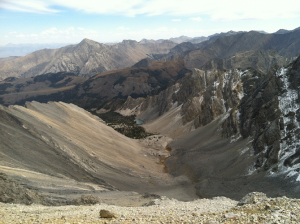Sand: fluid or solid?
PDF
Sand is one of the common materials in our environment. Symbolically attached to the seaside frame, it is nevertheless one of the basic materials used to make concrete. In addition, it is one of the elementary components of soils, and as such it is familiar to any geotechnical engineer. Born from the decomposition of crystalline rocks, it is often presented as a particularly illustrative example of granular materials, where the disordered arrangement of its grains will give it quite unique properties. This article proposes to review some of these properties, after recalling the origin of sand.
1. Where does the sand come from?

Sand is the ultimate state of degradation of many rocks, particularly magmatic rocks formed by deep crystallization, consisting of grains. Granitic rocks [1] are an excellent example, they are the main peaks of most high alpine massifs (Mont-Blanc, Ecrins, Ambin, Argentera). Erosion, an inevitable consequence of the ageing of the material under the influence of aggressive agents (mainly climatic), breaks down the rocks into smaller elements until they decompose into a granular assemblage, where the grains of the original rock are found (Figure 1). This assembly is called the granite arena. For example, for granite, we find mica crystals, feldspar crystals, and quartz crystals. Due to the ongoing physico-chemical alteration, only quartz grains often persist, forming the sand on riversides or beaches.
2. A story of grains

For the geotechnician, who is interested in soils in anticipation of future civil engineering works (construction of a road structure, a building, a dam, an offshore structure), the density of the sand that constitutes the soil is of paramount importance, because the mechanical behaviour (i.e. the way in which the soil deforms under the action of a given load) will not be at all the same whether the sand is dense or loose. And for most civil engineering works, it is essential to avoid that the ground deforms beyond a very strict limit!
3. Solid, air and water

In addition, the presence of a fluid in the sand can promote alteration and physico-chemical transformation processes, leading to the formation of solid bridges between the grains. A kind of cement appears between the grains, which improves the mechanical resistance of the soil. When this phenomenon of consolidation continues over very long periods of time on a geological time scale, we will speak of diagenesis, leading to the formation of a rock called grès.
4. In confidence of a granular material
Sand, as an example of granular material, has been a constant concern for soil mechanics since the 18th century with the founding work of C.A. Coulomb (see What is the Coulomb friction law?). Three centuries later, the light remains partial on all the mysteries that this material holds for us. Sometimes resistant like a “real” solid, sometimes fluid like a liquid. Think of the quicksand! More catastrophically, we keep in mind the major disorders that occur during an earthquake on sandy soils: the soils liquefy, no longer allowing the stability of the structures they support, leading to their ruin.

- On the one hand, rearrangement between grains, which can slide or roll relative to each other, modifying the granular structure (by decreasing or increasing voids between grains). This relative movement between the grains is controlled by the coefficient of friction between the grains (through Coulomb’s law), and the shape of the grains.
- On the other hand, the colossal number of grains contained even in a small volume (a handful of sand can contain billions of grains!). This results in a geometric complexity (effect of large numbers, observable in any large population, living or material), which can be perceived in the variety of entanglement patterns formed by the grains in contact, drawing kinds of grain chains in the middle of highly variable clusters, sizes and shapes (Figure 4). One of the most singular properties of sands, and which results in part from a collective effect, is dilatancy (see What is sand dilatancy?), reflecting the ability of a sand sample to increase in volume when subjected to shear stress.
One of the major current challenges for sand soil engineering is to pursue this fruitful path of understanding the behaviour of sands, by returning to their granular structure at the most elementary scales: that of the grain, or an elementary cluster of a few grains. Between the scale of the engineer, which extends to a few dozen metres, and that of the researcher, which goes down to the heart of the assembly of the grains, there is a disjunction whose resolution constitutes an authentic intellectual challenge.
References and notes
Cover photo: Reunion Island [© François Nicot]
[1] Granitic rocks refer to a family, of which granite is a representative. The gneiss or amphiboles of the Belledonne massif (Isère) belong to this family.
[2] A micrometer is a thousand times smaller than a millimeter : 1 mm = 1000 μm
The Encyclopedia of the Environment by the Association des Encyclopédies de l'Environnement et de l'Énergie (www.a3e.fr), contractually linked to the University of Grenoble Alpes and Grenoble INP, and sponsored by the French Academy of Sciences.
To cite this article: NICOT François (January 5, 2025), Sand: fluid or solid?, Encyclopedia of the Environment, Accessed January 15, 2025 [online ISSN 2555-0950] url : https://www.encyclopedie-environnement.org/en/soil/sand-fluid-or-solid/.
The articles in the Encyclopedia of the Environment are made available under the terms of the Creative Commons BY-NC-SA license, which authorizes reproduction subject to: citing the source, not making commercial use of them, sharing identical initial conditions, reproducing at each reuse or distribution the mention of this Creative Commons BY-NC-SA license.







